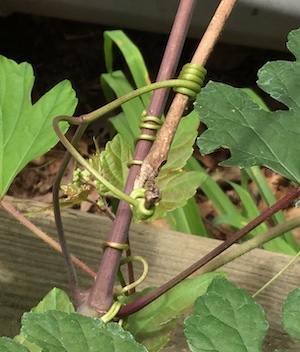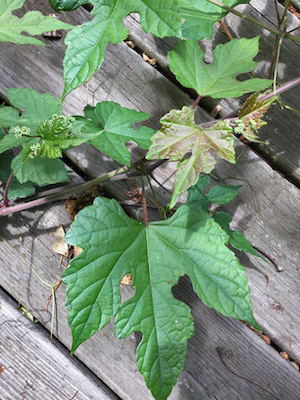Be Wary of the Invasive Porcelain-berry
By Mary David, Fairfax Master Gardener
 Like a number of other invasive plants, porcelain-berry (Ampelopsis glandulosa var. brevipedunculata) was introduced to the U.S. as a desirable ornamental landscape plant. It’s easy to see why. Its fall berries are stunning in speckled shades of pink, blue, lilac and purple. Unfortunately, despite its beauty, its debut here was a terrible mistake. Porcelain-berry is now near the top of any Mid-Atlantic’s “worst alien invaders” list.
Like a number of other invasive plants, porcelain-berry (Ampelopsis glandulosa var. brevipedunculata) was introduced to the U.S. as a desirable ornamental landscape plant. It’s easy to see why. Its fall berries are stunning in speckled shades of pink, blue, lilac and purple. Unfortunately, despite its beauty, its debut here was a terrible mistake. Porcelain-berry is now near the top of any Mid-Atlantic’s “worst alien invaders” list.
Porcelain-berry is a woody, perennial vine with simple, alternate, broadly ovate, dark-green leaves. These vary from heart-shaped to slightly lobed to deeply cut with pointed tips and coarsely toothed edges. The number of lobes also varies from three to five. Leaves measure up to 4 inches wide and 5 inches long. The undersides are slightly hairy to the touch, especially along the veins.

Porcelain-berry terndrils
At first glance, you might think the vine is wild grape because of the similarity in leaf shape and twining habit. You would be wrong, although understandably so, as the resemblance is close enough to fool most of us without further examination.
Obviously, the unusual, multi-colored berries are a dead giveaway in identifying the vine, but these do not appear until the fall. From June to August you can rely on porcelain-berry’s flowers to make an identification. These are small and inconspicuous, greenish-white in color, and arranged in compact upright clusters like an open umbrella. The flowers of wild grape bloom in early summer and in elongated hanging clusters.

Vine and leaves
Dry or wet, sun or shade, porcelain-berry will go anywhere—although it is less tolerant of extremely wet or heavy shade conditions. Poor soil or rich, the vine will take whatever it can get. It grows well on forest edges, thickets, river banks, and in woodlands where there are gaps in the tree canopy. It also does well in disturbed areas such as roadsides, fencerows, and railroad and utility rights-of-way. Porcelain-berry has also begun moving into open areas cleared by deer browsing.
To say that porcelain-berry is a vigorous grower would be an understatement. The vines can grow 20 feet in a single growing season, climbing up, over, and through anything in their path. They eventually form dense mats that overtake shrubs and young trees. While porcelain-berry competes with other plants for water, nutrients and space, it’s the mats that deal the killer blow by blocking out sunlight. Porcelain-berry does not crush or choke, it smothers.

Flowers
Although humans find the berries decidedly unsavory, birds and other wildlife do not. Birds in particular spread the seed in their droppings. Seed germinates easily and may be viable in the soil for several years.
Once established, porcelain-berry is difficult to remove. Hand-pulling can slow it down—and it’s a good first step—but there’s an extensive root system, and any part of the root left intact will produce new plants. It also has a deep taproot that is almost impossible to dig up.
Be sure to pull out the vines before the berries ripen in the fall and then again in the spring to prevent future flower buds. Follow-up with herbicides will likely be necessary. Whatever treatment method you choose, you should plan on repeating it throughout the growing season and for several years afterward.
Recommendations for Chemical Control
• You Ain’t from Around here! Exotic Invasive of the Quarter: Porcelain-berry, Jennifer Gagnon, Virginia
Forest Landowner Update. V. 32, No. 2, Spring 2018
• Stealthy and Insidious Invasive: Porcelain-berry, Blue Ridge Partnership for Regional Invasive Species
Management, Shenandoah National Park Trust, May 2017
References
• Unwanted and Unloved: Porcelain-berry, Suzanne Dingwell, Virginia Native Plant Society, August 2014
• Factsheet: Porcelain-berry, Plant Conservation Alliance’s Alien Plant Working Group, National
Park Service
• How to Control Invasive Plants: Manual, Mechanical, and Biological Methods, Blue Ridge Partnership for
Regional Invasive Species Management, Shenandoah National Park Trust